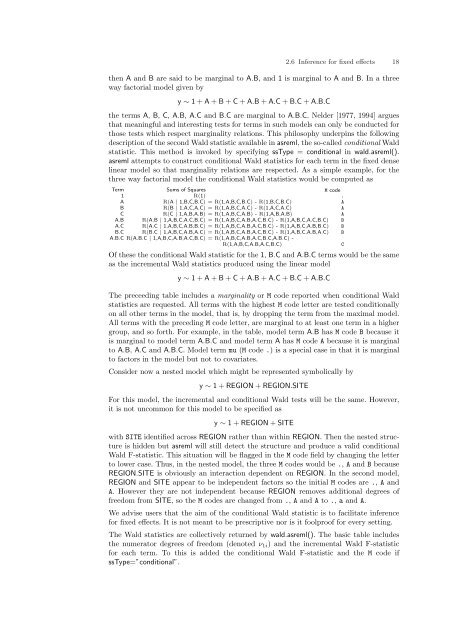ASReml-S reference manual - VSN International
ASReml-S reference manual - VSN International
ASReml-S reference manual - VSN International
- No tags were found...
You also want an ePaper? Increase the reach of your titles
YUMPU automatically turns print PDFs into web optimized ePapers that Google loves.
2.6 Inference for fixed effects 18then A and B are said to be marginal to A.B, and 1 is marginal to A and B. In a threeway factorial model given byy ∼ 1 + A + B + C + A.B + A.C + B.C + A.B.Cthe terms A, B, C, A.B, A.C and B.C are marginal to A.B.C. Nelder [1977, 1994] arguesthat meaningful and interesting tests for terms in such models can only be conducted forthose tests which respect marginality relations. This philosophy underpins the followingdescription of the second Wald statistic available in asreml, the so-called conditional Waldstatistic. This method is invoked by specifying ssType = conditional in wald.asreml().asreml attempts to construct conditional Wald statistics for each term in the fixed denselinear model so that marginality relations are respected. As a simple example, for thethree way factorial model the conditional Wald statistics would be computed asTerm Sums of Squares M code1 R(1) .A R(A | 1,B,C,B.C) = R(1,A,B,C,B.C) - R(1,B,C,B.C) AB R(B | 1,A,C,A.C) = R(1,A,B,C,A.C) - R(1,A,C,A.C) AC R(C | 1,A,B,A.B) = R(1,A,B,C,A.B) - R(1,A,B,A.B) AA.B R(A.B | 1,A,B,C,A.C,B.C) = R(1,A,B,C,A.B,A.C,B.C) - R(1,A,B,C,A.C,B.C) BA.C R(A.C | 1,A,B,C,A.B,B.C) = R(1,A,B,C,A.B,A.C,B.C) - R(1,A,B,C,A.B,B.C) BB.C R(B.C | 1,A,B,C,A.B,A.C) = R(1,A,B,C,A.B,A.C,B.C) - R(1,A,B,C,A.B,A.C) BA.B.C R(A.B.C | 1,A,B,C,A.B,A.C,B.C) = R(1,A,B,C,A.B,A.C,B.C,A.B.C) -R(1,A,B,C,A.B,A.C,B.C)COf these the conditional Wald statistic for the 1, B.C and A.B.C terms would be the sameas the incremental Wald statistics produced using the linear modely ∼ 1 + A + B + C + A.B + A.C + B.C + A.B.CThe preceeding table includes a marginality or M code reported when conditional Waldstatistics are requested. All terms with the highest M code letter are tested conditionallyon all other terms in the model, that is, by dropping the term from the maximal model.All terms with the preceding M code letter, are marginal to at least one term in a highergroup, and so forth. For example, in the table, model term A.B has M code B because itis marginal to model term A.B.C and model term A has M code A because it is marginalto A.B, A.C and A.B.C. Model term mu (M code .) is a special case in that it is marginalto factors in the model but not to covariates.Consider now a nested model which might be represented symbolically byy ∼ 1 + REGION + REGION.SITEFor this model, the incremental and conditional Wald tests will be the same. However,it is not uncommon for this model to be specified asy ∼ 1 + REGION + SITEwith SITE identified across REGION rather than within REGION. Then the nested structureis hidden but asreml will still detect the structure and produce a valid conditionalWald F-statistic. This situation will be flagged in the M code field by changing the letterto lower case. Thus, in the nested model, the three M codes would be ., A and B becauseREGION.SITE is obviously an interaction dependent on REGION. In the second model,REGION and SITE appear to be independent factors so the initial M codes are ., A andA. However they are not independent because REGION removes additional degrees offreedom from SITE, so the M codes are changed from ., A and A to ., a and A.We advise users that the aim of the conditional Wald statistic is to facilitate inferencefor fixed effects. It is not meant to be prescriptive nor is it foolproof for every setting.The Wald statistics are collectively returned by wald.asreml(). The basic table includesthe numerator degrees of freedom (denoted ν 1i ) and the incremental Wald F-statisticfor each term. To this is added the conditional Wald F-statistic and the M code ifssType=”conditional”.
















